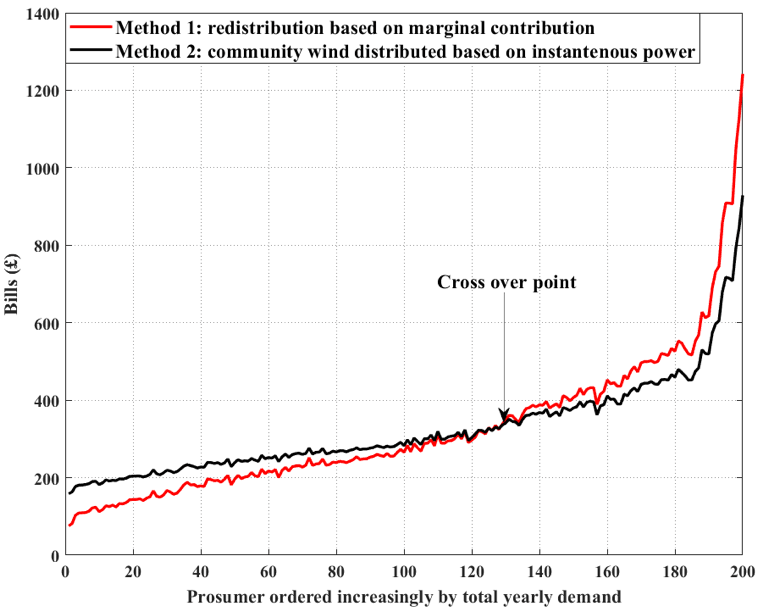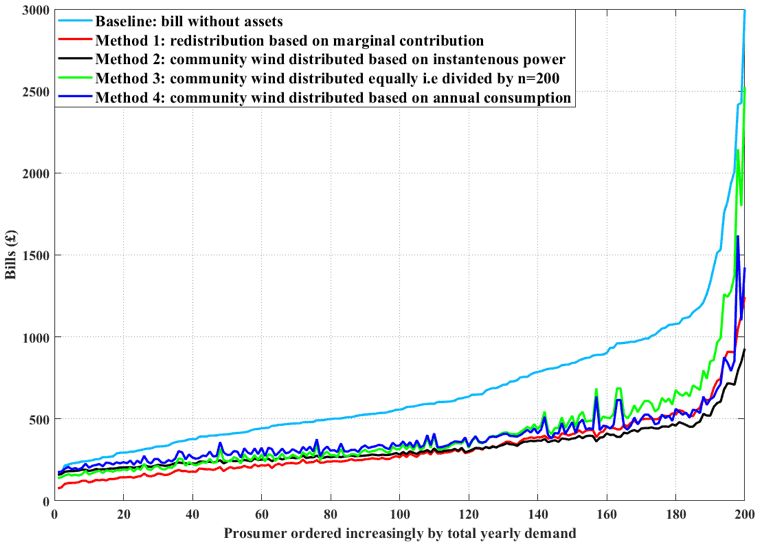by Sonam Norbu, Benoit Couraud, Merlinda Andoni, David Flynn (Heriot-Watt University, Edinburgh) and Valentin Robu (CWI and TU Delft)
In many smart energy communities all over the world, consumers are joining forces to jointly invest in their own renewable energy generation (wind turbine, solar panels) and battery assets. But how can we efficiently control the community-owned infrastructure, and fairly distribute the output among consumers of different sizes and consumption profiles? Researchers at CWI Amsterdam and Heriot-Watt University in Edinburgh, Scotland, are using techniques from distributed artificial intelligence to address this challenge.
One of the aims of smart cities is to reduce the carbon footprint of the citizens’ energy consumption by supporting a novel decentralised production and by leveraging the new digital and smart grid technologies for the energy system. This will enable consumers to take control of their own energy generation and consumption. A recent trend, emerging in both rural communities and smart city neighbourhoods, is for groups of household prosumers to form local energy communities that invest together in jointly owned renewable generation and storage systems, sharing the benefits from these assets. Examples include the Responsive Flexibility project on the Orkney Islands [L1] the Brooklyn Microgrid project in the US, the Grid Friend project in Amsterdam North, and the many energy communities emerging in developing countries, such as Auroville in India. Looking forward, such energy communities are expected to play a key role in building a more decentralised, decarbonised, and democratised energy system in which consumers use more locally-generated renewable energy, and take control of their energy supply.
Challenges
Energy community projects, which have been established in both urban and rural environments, often involve jointly owned assets such as community-owned wind turbines, PVs and/or shared battery storage. The Responsive Flexibility (ReFLEX) project (the UK’s largest smart energy demonstrator) is studying one of these communities on the Orkney Islands in Scotland [L1], comprising 200 households that share a wind turbine and storage (i.e., a community battery). Our model uses high granularity (half-hourly) consumption and generation data from each household.
While energy communities are a promising concept, a key challenge is how these assets can be efficiently controlled in real time, how the useful lifetime of the asset can be modelled and enhanced using AI, and how the energy outputs from these jointly owned assets should be shared fairly among community members, given that not all members have the same size, energy needs or demand profiles.
Solution and results
To address these challenges, we have developed new algorithms for smart control of energy assets and redistribution mechanisms that yield to fairer ways to divide joint gains, using the tools from distributed AI and cooperative game theory. First, we compare the case when individual households invest in their own home energy assets (renewable generator, storage) vs. investing in a larger jointly owned community energy asset. Our case study and dataset clearly show the benefits of a jointly owned or pooled energy assets approach. Next, we provide several practical and computationally efficient mechanisms to share the outputs from these jointly owned assets between homes in a fair way [1]. Our work makes use of the key concept of marginal value – borrowed from coalitional game theory and distributed AI, looking at what each member contributes to (and costs) the local community.
Figure 1 shows the annual bills of individual households after redistribution of community savings obtained from the jointly owned community energy assets for different redistribution schemes. The advantages of the proposed redistribution mechanism based on marginal contribution of each household, denoted as Method 1 in red, are that it yields to the lowest bill for the whole community, and thus the greatest savings for the community households. For Method 1 and Method 2, we performed a further comparison to evaluate the economic fairness in the redistribution scheme (see Figure 2). The crossover point between the redistributed bill curves in Figure 2 shows that the proposed marginal cost redistribution method yields to a greater reduction of the annual bill for 67% of the community households compared to method 2. Hence, under the proposed marginal redistribution method, more households can decrease their annual bills than the existing state-of-art redistribution method.

Figure 1: Individual households’ yearly bills after redistribution by marginal cost redistribution method and currently practiced state-of-the-art redistribution methods.

Figure 2: Individual households’ yearly bills after redistribution by marginal cost redistribution method and instantaneous power redistribution method.
While it is true that large consumers benefit slightly less under our scheme, these households with higher demand profiles are the households who already obtain the highest bill reduction in value as compared to households with lower demand profiles as illustrated in Figure 1. Therefore, the proposed redistribution mechanism achieves a fairer redistribution than does the current redistribution scheme. From a pragmatic perspective, having 67% of households in the community, which are mainly small consumers, benefiting from the proposed redistribution mechanism would lead to greater social acceptance, and hence to more communities forming coalitions to invest in jointly owned renewable energy assets.
![Figure 3: Wind turbines deployed on Orkney Islands, Scotland, UK – the “living lab” for the smart local energy demonstrator project Responsive Flexibility (ReFLEX) [courtesy: EMEC/ReFLex].](/images/stories/EN127/robu1.jpg)
Figure 3: Wind turbines deployed on Orkney Islands, Scotland, UK – the “living lab” for the smart local energy demonstrator project Responsive Flexibility (ReFLEX) [courtesy: EMEC/ReFLex].
Further work
Furthermore, we have extended the proposed redistribution mechanism to integrate physical network/grid constraints [2], which are key for building realistic distribution grid models. Another potential extension involves modelling other use cases using these methods, such as energy communities in cities such as New Delhi in India [L2], sharing solar panels and a battery unit.
Links:
[L1] https://www.reflexorkney.co.uk/
[L2] https://cedri.hw.ac.uk/
References:
[1] S. Norbu, et al.: “Modelling the redistribution of benefits from joint investments in community energy projects,” Appl. Energy, vol. 287, p. 116575, 2021. https://doi.org/10.1016/j.apenergy.2021.116575
[2] S. Norbu, et al.: “Modeling Economic Sharing of Joint Assets in Community Energy Projects Under LV Network Constraints,” IEEE Access, vol. 9, pp. 112019–112042, 2021. https://doi.org/10.1109/ACCESS.2021.3103480
Please contact:
Valentin Robu
CWI, The Netherlands











